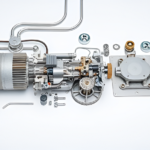Nanofiber technology is rapidly advancing and finding applications across various industries, including food and agriculture. As these sectors face challenges like sustainability, food safety, and efficient production, nanofibers offer innovative solutions to meet growing demands. With their unique properties, nanofibers are now shaping the future of agriculture and food processing, contributing to enhanced safety, longer shelf lives, and sustainable farming practices.
What Are Nanofibers?
Nanofibers are ultra-thin fibers with diameters ranging from nanometers to micrometers, typically produced using methods like electrospinning. These fibers have high surface area-to-volume ratios, tunable porosity, and exceptional mechanical strength, making them ideal for various applications. In the food and agriculture industries, nanofibers provide advanced materials with properties that can significantly improve current processes and systems.
Nanofiber Technology in Food Packaging
One of the most significant contributions of nanofiber technology to the food industry is in packaging. Food packaging is crucial for ensuring food safety, extending shelf life, and maintaining quality. Traditional packaging materials often struggle to meet these requirements as consumer demands for fresher, more natural, and preservative-free foods grow. Nanofibers, with their unique properties, offer solutions to these challenges.
Nanofibers can be incorporated into packaging materials to create active and intelligent packaging systems. Active packaging involves the release or absorption of substances that improve the quality or safety of the food product. For example, nanofibers can be embedded with antimicrobial agents that inhibit the growth of bacteria, extending the shelf life of perishable foods like fruits, vegetables, and meat. Intelligent packaging, on the other hand, can include nanofibers that react to changes in the environment, such as humidity or temperature, providing real-time information about the product’s freshness.
Additionally, the high surface area of nanofibers allows for better control over gas permeability in packaging materials. This is crucial for maintaining the ideal atmosphere inside the packaging, particularly for fresh produce that continues to respire after harvesting. By controlling oxygen and carbon dioxide levels, nanofiber-based packaging can slow down the deterioration process and reduce food waste.
Nanofiber-Based Sensors in Food Safety
Food safety is a growing concern globally, and ensuring that food products are free from harmful contaminants is a top priority. Nanofiber technology is paving the way for the development of highly sensitive sensors that can detect pathogens, toxins, and spoilage in real time. These sensors are small, cost-effective, and can be integrated into packaging materials or used in quality control processes.
Nanofiber-based sensors work by detecting changes in the chemical composition of the food or its environment. For example, they can be engineered to detect the presence of harmful bacteria like Salmonella or E. coli, which are common contaminants in the food supply chain. These sensors can provide immediate feedback, allowing for quicker interventions and reducing the risk of foodborne illnesses.
Moreover, nanofibers can be functionalized with specific molecules that interact with targeted contaminants, enabling highly selective detection. This high sensitivity is essential for identifying even trace amounts of harmful substances, ensuring that food products meet safety standards before they reach consumers.
Enhancing Food Preservation with Nanofibers
Another critical application of nanofiber technology in the food industry is in preservation. As food waste continues to be a significant global challenge, finding methods to preserve food for longer periods is essential. Nanofibers, thanks to their large surface area and customizable properties, can be used to create coatings that enhance the preservation of food items.
For instance, nanofiber coatings can be applied to fresh produce to form a protective barrier against moisture and microbial growth, extending shelf life without the need for chemical preservatives. These coatings are thin, biodegradable, and can be tailored to the specific needs of different food products. For example, a nanofiber coating on fruits can slow down oxidation, while a coating on meat products can inhibit bacterial growth.
Nanofibers can also be incorporated into edible films, which serve as an alternative to synthetic preservatives. These edible coatings are not only safe for consumption but can also carry functional ingredients such as antioxidants, vitamins, or probiotics, further enhancing the nutritional value of the food.
Nanofiber Technology in Agriculture
Beyond food processing and packaging, nanofiber technology is making waves in agriculture, offering solutions to some of the most pressing challenges faced by farmers today. Sustainable farming practices, improved crop yields, and efficient resource utilization are key goals for modern agriculture, and nanofibers are playing a pivotal role in achieving them.
One of the most promising applications of nanofibers in agriculture is in the development of controlled-release systems for fertilizers and pesticides. Traditional methods of applying fertilizers and pesticides often lead to overuse, environmental pollution, and inefficient delivery to plants. Nanofibers can be engineered to release these substances in a controlled manner, ensuring that plants receive the necessary nutrients or protection when needed.
Nanofibers used in controlled-release systems can encapsulate active ingredients like fertilizers or herbicides, allowing for slow and sustained release. This not only reduces the amount of chemicals needed but also minimizes environmental runoff and contamination of water sources. By optimizing the delivery of nutrients and pesticides, farmers can improve crop yields while reducing their ecological footprint.
Nanofiber-Based Sensors for Precision Agriculture
Precision agriculture, which involves using technology to monitor and manage crops more efficiently, is gaining popularity among farmers. Nanofiber-based sensors are a key component of this approach, offering real-time monitoring of soil health, water usage, and crop conditions.
For example, nanofiber sensors can be embedded in the soil to measure moisture levels, allowing farmers to optimize irrigation and reduce water waste. Similarly, these sensors can detect nutrient levels in the soil, providing data that can inform more precise fertilization practices. By utilizing nanofiber technology in sensor systems, farmers can make data-driven decisions that improve crop health, reduce resource waste, and enhance sustainability.
Promoting Sustainable Agriculture with Nanofibers
Sustainability is at the heart of modern agricultural practices, and nanofiber technology is contributing to this goal in various ways. In addition to controlled-release systems and precision agriculture, nanofibers are being explored as materials for biodegradable mulches and soil stabilizers. These materials help protect soil health, reduce erosion, and improve water retention, all of which are critical for sustainable farming.
Moreover, nanofibers can be used to develop biodegradable seed coatings that protect seeds from pests and diseases during germination, leading to higher crop success rates. Unlike conventional coatings, which often contain synthetic chemicals, nanofiber-based coatings are environmentally friendly and decompose naturally over time.
Conclusion
Nanofiber technology is revolutionizing the food and agriculture sectors by offering innovative solutions to long-standing challenges. From enhancing food packaging and safety to improving crop yields and promoting sustainability, nanofibers have the potential to transform the way we produce, process, and consume food. As research and development continue to advance, the role of nanofibers in food and agriculture will only grow, offering new opportunities for a more efficient, sustainable, and safe global food system.












